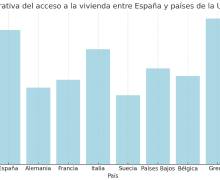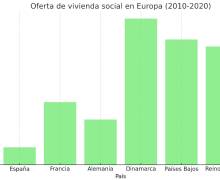Access to the first home: the difficult reality for young people and local citizens in Spain

Accessing the first home is one of the main problems faced by young people and local citizens in Spain. Despite government efforts and political measures, housing prices have outpaced wage growth, and the supply of properties has failed to meet demand, creating a complex scenario for those seeking to access their first home.
1. Evolution of wages vs housing prices over the past 20 years
In the last two decades, housing prices in Spain have grown at a much faster pace than wages. According to data from the National Statistics Institute (INE), wages increased by an average of 16% between 2002 and 2022. In contrast, housing prices have risen by more than 150% in some areas, especially in cities like Madrid, Barcelona, and the Costa Blanca.
This mismatch has increased the difficulty for young people, who need to allocate an increasing proportion of their income to mortgage or rent payments. Whereas it was previously recommended not to spend more than 30% of monthly income on housing, this percentage has now risen to more than 40% or even 50% in some areas.
{image}
2. Price increase after the COVID-19 pandemic
The COVID-19 pandemic introduced new dynamics into the real estate market. Although an initial price drop was expected due to economic uncertainty, the reality was different. Lockdowns and the rise of remote work led to an increase in demand for larger homes with outdoor spaces. In areas like the Costa Blanca, second-hand home prices rose between 7% and 10% since 2020.
Additionally, new developments have fueled demand for luxury homes, especially in coastal areas. This has further driven up prices, making it even more difficult for local residents to compete with international buyers.
3. Demand vs supply of available properties
Another key factor is the limited housing supply compared to growing demand. Over the past decade, housing construction has not kept pace with demand, particularly in large cities and coastal areas like the Costa Blanca. According to the Ministry of Transport, Mobility, and Urban Agenda, fewer homes were built between 2007 and 2022 than in the previous decade, due to the 2008 housing crisis and subsequent economic recession.
This supply shortage has driven up sales and rental prices, particularly in tourist areas where foreign property purchases have further reduced availability for local citizens. The lack of social and affordable housing is a recurring problem, as only 2.5% of all housing built in Spain between 2010 and 2020 was social housing, far below the European average of around 9%.
4. Comparison with other European Union countries
Spain is in a worse position than the European average in terms of housing accessibility. According to Eurostat, in 2023, 35% of young Spaniards between the ages of 25 and 34 still lived with their parents, a figure much higher than the European average of 22%. Furthermore, Spain is among the EU countries where the financial effort required to buy a home is the highest.
In comparison, countries like Germany or France have implemented more effective price control policies and increased social housing construction, reducing the impact of price increases. In Spain, the measures are more limited, and access to housing has become one of the main concerns of the population.
5. Possible solutions and forecasts for the future
In the short term, it is essential for the government to adopt stronger measures to facilitate access to housing. Some possible solutions include:
• Promotion of social housing: Increase investment in subsidized housing to expand the supply of affordable properties for young people and local citizens.
• Rental regulation: Implement measures to control rental prices, especially in areas where tourism has increased real estate speculation.
• Incentives for affordable housing construction: Provide tax and regulatory incentives to developers focused on building homes for the middle and working classes.
• Greater access to mortgage credit: Promote mortgage loans with more favorable conditions for young people, making it easier for them to enter the market.
In the coming years, if effective measures are not adopted, the situation is likely to worsen, with continuous price increases and greater difficulty accessing housing. However, if the government and institutions implement the right reforms, it is possible to achieve a balance between supply and demand that allows for fairer access to the real estate market.






























